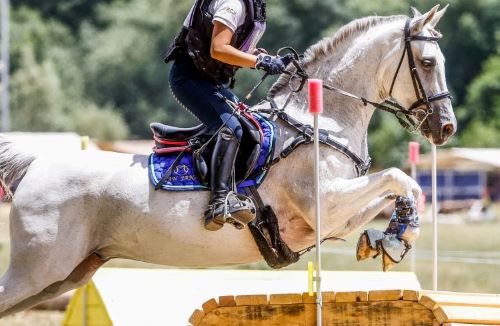Introduction to Eventing
This is my favorite riding discipline. I was working toward riding in cross-country/eventing competitions, but I had too many falls off of my other horse, with broken ribs and more, that I had to promise my employer that I wouldn’t jump.
That was tough. I didn’t really quit jumping, but I didn’t compete in it. I stayed with Dressage, which is usually easier on the body.
Table of Contents
- Introduction to Eventing
- Getting Started in Eventing
- Understand This – Your Equipment is Your Best Ally
- Training for Your First Event
- Preparing for the Competition
- Essential Eventing Rules and Etiquette
- Closing Thoughts on Beginning Your Eventing Journey
Cross-country equestrian jumping is one of the three phases in the sport of eventing. It can also stand alone as a competition, often called hunter trials or simply “cross-country,” typically held as lower-level, local events.
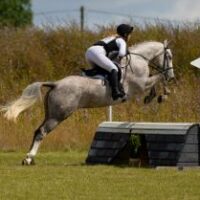
I will walk you through the ins and outs of eventing. Suppose you’re new to the equestrian scene. In that case, you’ll find out about this thrilling sport, which combines the elegance of dressage, the adrenaline rush of cross-country, and the precision of show jumping into one competition. Eventing is not just an athletic challenge for horses and riders; it’s a rigorous test of their communication, skill, and endurance.
Eventing has three distinct phases, each assessing different aspects of horsemanship.
- First is Dressage, the ballet of equestrian sports, where horses and riders perform a sequence of predetermined movements called ‘tests’.
- Next is the cross-country phase, which is like a steeplechase with natural obstacles and varying terrain.
- Show jumping rounds out the competition, testing the duo’s ability to navigate a course of fences accurately.
Most people are keen to watch the cross-country phase. This phase can also stand alone as a competition, often called hunter trials or simply “cross-country,” which is typically held as lower-level, local events.
What is the history behind all this? Eventing has its roots in a comprehensive cavalry test requiring soldiers to master a variety of riding skills. It evolved into a competitive sport and made its Olympic debut in 1912. Today, eventing is a celebrated equestrian discipline with events held worldwide, attracting riders who relish the challenge of excelling in all three phases.
Getting Started in Eventing
I will walk you through the initial steps to ‘jump’ into the world of eventing. This isn’t just about getting your feet wet; it’s a full plunge into a thrilling equestrian sport.
First, understanding the different levels of competition is crucial. Eventing tiers range from beginner or intro levels to advanced, each with its own challenges and requirements. I suggest starting at a comfortable level for both you and your horse.
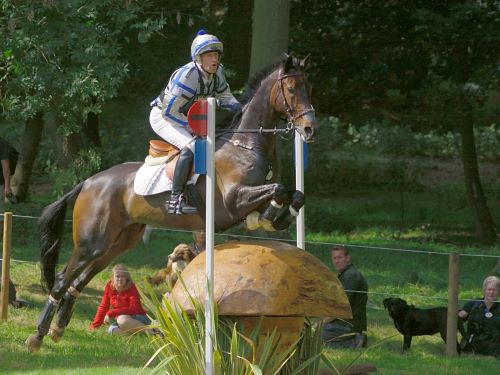
Don’t be surprised if, at the beginning, you select a tier that is too tough for you. The jumping part may seem easy to people just starting out in eventing. You may have jumped obstacles like this before. The Dressage phase may look easy to a novice. It’s not. This is where you need to concentrate. You need the lower scores in Dressage to advance in the jumping phases.
Understand This – Your Equipment is Your Best Ally
What You Need – The Basics
- a saddle,
- bridle,
- protective boots,
- and safety gear like
- a helmet
- and body protector for yourself.
Always opt for quality and comfort because in eventing, gear isn’t just about looks—it’s about performance and safety.
Finding a qualified coach or trainer can make a world of difference. I was lucky to find a good trainer, Kathy Daly, fairly early in my competition life. A good trainer will guide you through the complexities of the sport and ensure you and your horse are competition-ready. Choose someone that resonates with you—you’ll be spending a lot of time together.
You can always adjust your approach as you grow in the sport, but it’s key to start on the right ‘hoof’, lol. So, as you mull over this information, don’t focus too much on perfection. Your first attempt doesn’t need to be your last. Instead, it’s about learning and enjoying the journey with your equine partner.
Training for Your First Event
Embarking on your first eventing competition can be exhilarating, but it will also require dedication. Your trio of disciplines—dressage, cross-country, and show jumping—demand distinct skill sets, both for you and your horse.
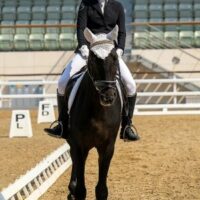
Let’s start with the choreography of horse and rider: dressage. This phase lays the foundation for the rest of the competition, emphasizing precision, elegance, and harmony. Begin with the basics—work on your posture, the horse’s gait transitions, and maintaining a steady rhythm. The secret here is consistency, so regular practice sessions are key.
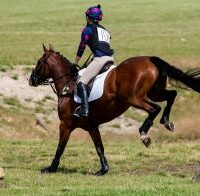
Now for the adrenaline rush—cross-country. Building trust between you and your mount is crucial, as you’ll face natural obstacles like water, ditches, and logs. Start with lower fences, and gradually introduce more complex challenges as your confidence grows. Cross-country is a test of endurance, so cardiovascular fitness for you and your horse is paramount.
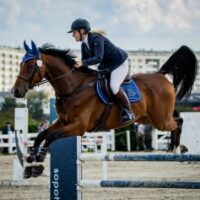
Show jumping is all about accuracy and timing. Jump courses are designed to challenge your ability to navigate a series of obstacles. Practice will include lots of repetitive drills to help your horse understand stride lengths and improve your reflexes for tight turns and swift corrections.
In my opinion, the most successful eventing pairs are those with a strong bond. So, don’t forget to invest time in simply getting to know your horse—its likes, dislikes, and cues. This connection will shine through in competition.
Remember, eventing is a marathon, not a sprint. Your first attempt doesn’t need to be your last, so learn from every round and every jump. Now, you’re ready to take the final steps before the big day.
Preparing for the Competition
You’ve clocked in countless hours of training, and the event day is just around the corner. Here’s what you’ll find out about ensuring you’re as ready as your horse when the big day arrives.
Know the itinerary. Eventing competitions typically start with dressage, followed by cross-country, and end with show jumping on the last day. Each phase has its schedule, and you must be fully aware of the timings.
Your pre-competition checklist is essential. This isn’t just about ensuring you have all the necessary tack and attire for you and your horse; it’s also about attending to all those last-minute details.
It’s critical that you have –
- your competition numbers,
- health papers for your horse,
- and any other required documents.
The day before the competition, pack up your gear. Double-check that you have everything you need – helmets, boots, saddles, bridles, grooming supplies, and of course, treats for your horse.
Don’t forget to take care of yourself, too. A good night’s sleep will keep you sharp, and eating a healthy meal will give you the energy you need to compete at your best.
Your horse’s well-being is paramount. In the run-up to the event, stick to your usual feeding and exercise routine to keep your horse settled. If you make nutritional adjustments for increased energy or focus, plan to do this well in advance to avoid any adverse reactions.
Remember, a successful competition is about showing up well-prepared. You can always adjust your approach down the road, but a solid foundation will set you up for success on your first eventing experience.
Essential Eventing Rules and Etiquette
What’s an eventing competition without a set of ground rules and proper conduct? This section will explain the framework that keeps the sport fair and enjoyable for everyone involved. It’s not just about the dos and don’ts; it’s also about embracing the spirit of eventing. Each element plays a vital role, from scoring intricacies to the value of good sportsmanship.
Scoring in eventing is unique, blending precision, speed, and form. Your performance in each phase determines your overall score. Lower scores mean better performance here, which is a bit different from what you might expect in other sports. Understanding penalties for refusals, falls, or time penalties is crucial. I’ll walk you through the common reasons for penalties so you can avoid them.
Safety is paramount. Helmets, body protectors, and proper footwear are more than just recommended—they’re often mandatory. This event isn’t just about looking good; it’s about staying safe. Always check the rules about equipment for both horse and rider; they’re updated regularly to prioritize welfare.
Your attire speaks volumes in eventing. It’s part of the tradition, but don’t worry too much about it; choose something that fits well and is within the regulations. For dressage, think polished and poised. Cross-country colors can express your personality, but in show jumping, tradition usually retakes the reins.
I’m here to teach you sportsmanship, too. Acknowledge your fellow competitors, be gracious in victory, and be considerate in defeat. This community is thrilling and supportive, so show gratitude to organizers, volunteers, and fellow eventers whenever you can. A thank you can go a long way here.
Closing Thoughts on Beginning Your Eventing Journey
I will wrap up our beginner’s guide to eventing, but this is just the starting point of an exhilarating adventure. Eventing isn’t just about the competition; it’s also about the incredible bond you’ll form with your horse and the personal achievements you’ll experience along the way.
Don’t worry too much about getting everything perfect on your first try. Eventing is a learning process; every competition can teach you something new about your horse, your skills, and yourself. You can always adjust your approach as you gain more experience and confidence.
Choose something that resonates with you – a particular phase of eventing, a style of training, or a role model in the sport – and use that as your inspiration. Remember, this sport has a lot of opportunities to grow and push your boundaries.
If you’re excited about the prospect of entering your first eventing competition, I hope you take that next step. Start attending events, get involved with your local eventing community, and maybe even volunteer. It’s not just about riding but being part of something bigger.
Finally, I’d love to hear your feedback on this guide or any questions you might have as you embark on your eventing journey. Drop your comments below, and let’s help each other progress in this thrilling sport. Here’s to your success in the eventing arena!
